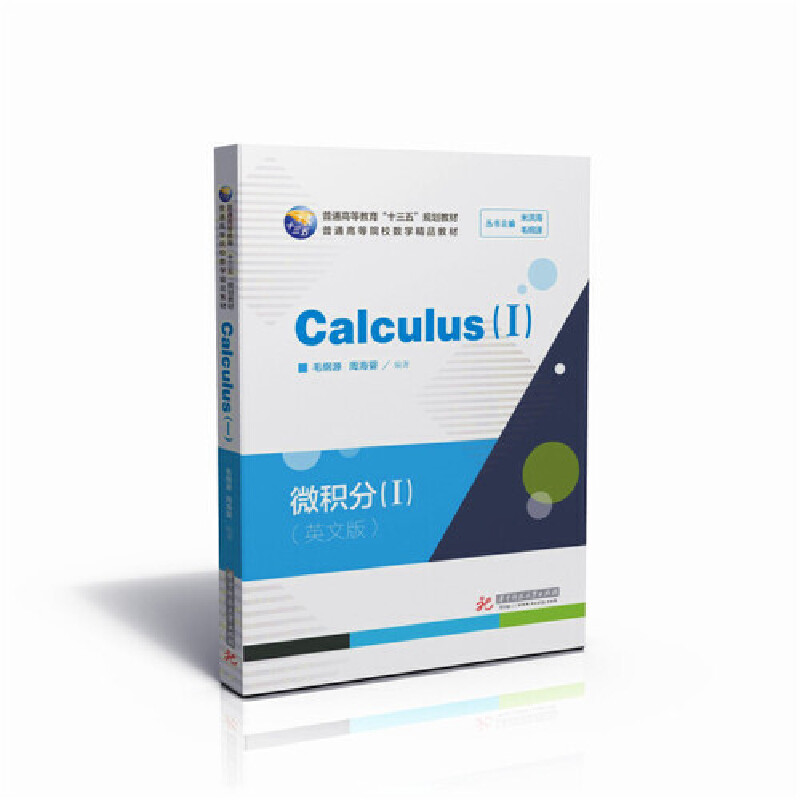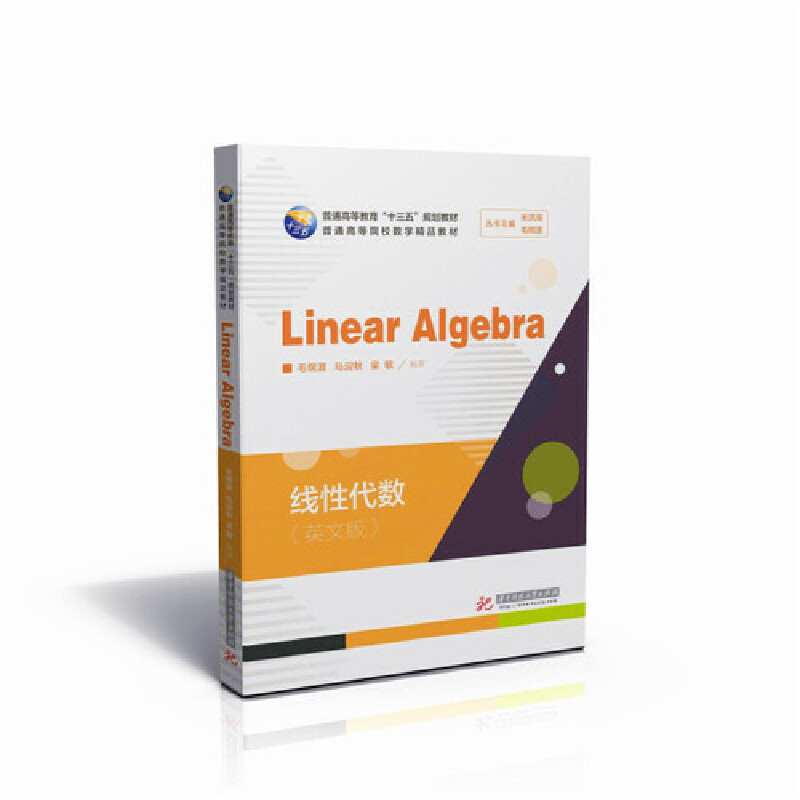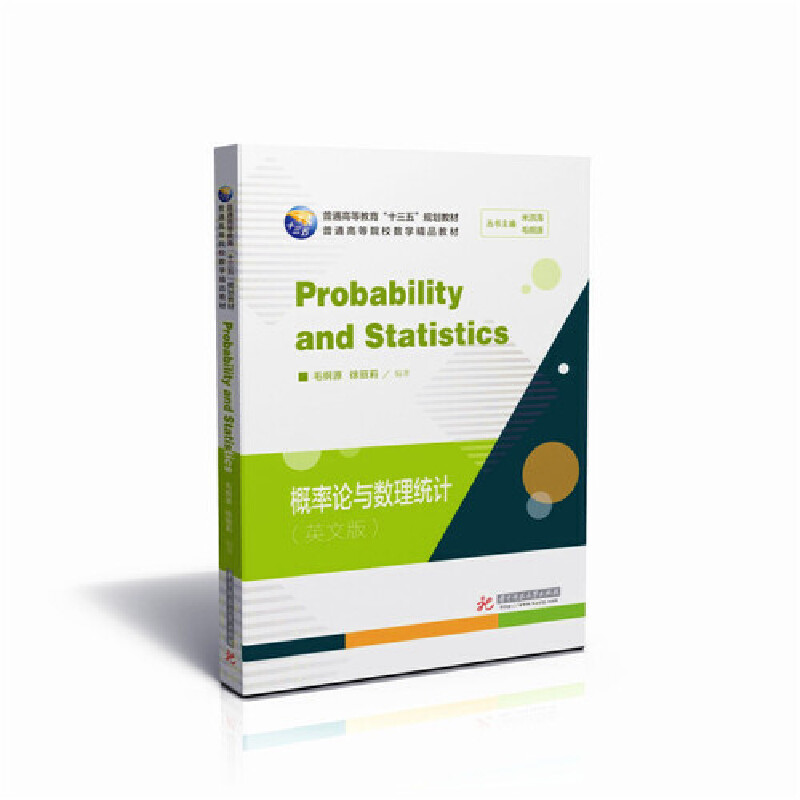微积分 I(英文版)
定价:¥42.80
作者: 毛纲源,周海婴
出版时间:2017-12
出版社:华中科技大学出版社
- 华中科技大学出版社
- 9787568028394
- 1-1
- 205260
- 60241832-9
- 平装
- 16开
- 2017-12
- 276
- 理学
- 数学类
- O172
- 金融学、经济数学、金融管理等
- 本科
作者简介
内容简介
本书采用学生易于接受的知识结构和英语表述方式,科学、系统地介绍了微积分(上册)中函数的概念、极限和连续、导数和微分、中值定理和导数的应用、不定积分和定积分等知识。强调通用性和适用性,兼顾先进性。本书起点低,难度坡度适中,语言简洁明了,不仅适用于课堂教学使用,同时也适用于自学自习。全书有关键词索引,习题按章配置,题量适中,题型全面,书后附有答案。
本书读者对象为高等院校理工、财经、医药、农林等专业大学生和教师,特别适合作为中外合作办学的国际教育班的学生以及准备出国留学深造学子的参考书。
本书读者对象为高等院校理工、财经、医药、农林等专业大学生和教师,特别适合作为中外合作办学的国际教育班的学生以及准备出国留学深造学子的参考书。
目录
Chapter 1 Functions(1)
1.1 Preliminary knowledge(1)
1.1.1 Inequalities and their properties(1)
1.1.2 Absolute value and its properties(5)
1.1.3 The range of variable(8)
1.2 Functions(10)
1.2.1 Concept of functions(10)
1.2.2 Features of a function(12)
1.2.3 Inverse functions(16)
1.2.4 Composite functions(19)
1.2.5 Elementary functions(20)
1.2.6 Nonelementary functions(30)
1.2.7 Implicit functions(33)
Exercise 1(33)
Chapter 2 Limit and Continuity(36)
2.1 Limit(36)
2.1.1 Definition of a sequence(36)
2.1.2 Descriptive definition of limit of a sequence(36)
2.1.3 Quantitative definition of limit of a sequence(38)
2.2 Limits of functions(39)
2.2.1 Definition of finite limits of functions as x→x0(39)
2.2.2 Definition of infinite limits of functions as x→x0(42)
2.2.3 Limits of functions as independent variable tending to infinity(44)
2.2.4 Left limit and right limit(47)
2.2.5 The properties of limits of functions(48)
2.2.6 Operation rules of limits(50)
2.2.7 Criteria of existence of limits and two important limits (54)
2.2.8 Infinitesimal, infinity and their basic properties(58)
2.2.9 Simple application of limit in economics(62)
2.3 Continuity of functions(64)
2.3.1 Continuity(64)
2.3.2 Discontinuous points of a function(68)
2.3.3 Operations and properties of continuous functions(69)
2.3.4 Continuity of elementary functions(72)
2.3.5 Continuity of the inverse functions(73)
2.3.6 Properties of continuous functions on closed interval(73)
Exercise 2(76)
Chapter 3 Derivative and differential(80)
3.1 Concept of derivative(80)
3.1.1 Introduction of derivative(80)
3.1.2 Definition of derivative(82)
3.1.3 Lefthand derivative and righthand derivative(84)
3.1.4 The relationship between differentiability and continuity of functions(85)
3.1.5 Applying the definition of derivative to find derivatives(87)
3.1.6 Geometric interpretation of derivative(91)
3.2 Rules of finding derivatives(91)
3.2.1 Four arithmetic operation rules of derivatives(91)
3.2.2 Derivative rules of composite functions(93)
3.2.3 Derivative rules of inverse functions(95)
3.2.4 Derivative rules of implicit functions(96)
3.2.5 Derivative rules of function with parametric forms(97)
3.2.6 Some special derivative rules(98)
3.2.7 Basic differentiation formulas(100)
3.2.8 Derivatives of higher order(102)
3.3 Differentials of functions(104)
3.3.1 Definition of differentials(104)
3.3.2 The equations of a tangent and a normal(107)
3.3.3 Formulas and operation rule of differentials(109)
3.3.4 Application of differentials in approximating values(111)
Exercise 3(112)
Chapter 4 The mean value theorems and application of derivatives(116)
4.1 The mean value theorems(116)
4.1.1 Rolle’s theorem(116)
4.1.2 Lagrange’s theorem(118)
4.1.3 Cauchy’s theorem(121)
4.2 L’Hospital’s rule(123)
4.2.1 Evaluating limits of indeterminate forms of the type 00(124)
4.2.2 Evaluating the limits of indeterminate forms of the type ∞∞(126)
4.2.3 Evaluating the limits of other indeterminate forms(127)
4.3 Taylor formula(129)
4.4 Discuss properties of functions by derivatives(136)
4.4.1 Monotonicity of functions(136)
4.4.2 Concavity and Convexity(140)
4.5 Extreme values(143)
4.6 Absolute maxima (minima) and its application(148)
4.6.1 Absolute maxima (minima)(148)
4.6.2 Applied problems of absolute maxima (minima)(150)
4.7 Graphing(152)
4.7.1 Asymptotes lines of curves(152)
4.7.2 Sophisticated graphing(154)
4.8 Application of derivatives in economics(158)
4.8.1 Marginal analysis(158)
4.8.2 Elasticity of function(164)
Exercise 4(169)
Chapter 5 Indefinite integrals(173)
5.1 Antiderivative and indefinite integral(173)
5.1.1 Concept of antiderivatives(173)
5.1.2 Concept of indefinite integrals(175)
5.2 Fundamental integral formulas(177)
5.3 Integral methods of substitution(180)
5.3.1 The first kind of substitution(180)
5.3.2 The second kind of substitution(185)
5.4 Integration by parts(189)
5.5 Evaluate indefinite integrals of some special type(194)
5.5.1 Integrals of rational functions(194)
5.5.2 Integrals of irrational functions(198)
5.5.3 Integrals of trigonometric functions(199)
5.5.4 Integral of piecewise defined function(201)
Exercise 5(202)
Chapter 6 Definite integrals(205)
6.1 Definition of definite integrals(205)
6.1.1 Two examples for definite integrals(205)
6.1.2 Definition of definite integrals(207)
6.1.3 Geometric meaning of definite integrals(211)
6.2 Basic properties of definite integrals(212)
6.3 Fundamental theorem of calculus(219)
6.3.1 A function of upper limit of integral(219)
6.3.2 NewtonLeibniz formula(222)
6.4 Integration by substitution and by parts for definite integrals(224)
6.4.1 Integration by substitution for definite integrals(225)
6.4.2 Integration by parts for definite integrals(229)
6.5 Improper integrals(231)
6.5.1 Improper integrals on infinite intervals(231)
6.5.2 Improper integrals of unbounded functions(239)
6.6 Application of integrals(241)
6.6.1 Computing areas of plan figures(241)
6.6.2 Volume of a solid of revolution(245)
6.6.3 Some economic applications of integrals(247)
Exercise 6(249)
Answers to exercises(256)
Answers to exercise1(256)
Answers to exercise2(257)
Answers to exercise3(257)
Answers to exercise4(259)
Answers to exercise5(261)
Answers to exercise6(262)
1.1 Preliminary knowledge(1)
1.1.1 Inequalities and their properties(1)
1.1.2 Absolute value and its properties(5)
1.1.3 The range of variable(8)
1.2 Functions(10)
1.2.1 Concept of functions(10)
1.2.2 Features of a function(12)
1.2.3 Inverse functions(16)
1.2.4 Composite functions(19)
1.2.5 Elementary functions(20)
1.2.6 Nonelementary functions(30)
1.2.7 Implicit functions(33)
Exercise 1(33)
Chapter 2 Limit and Continuity(36)
2.1 Limit(36)
2.1.1 Definition of a sequence(36)
2.1.2 Descriptive definition of limit of a sequence(36)
2.1.3 Quantitative definition of limit of a sequence(38)
2.2 Limits of functions(39)
2.2.1 Definition of finite limits of functions as x→x0(39)
2.2.2 Definition of infinite limits of functions as x→x0(42)
2.2.3 Limits of functions as independent variable tending to infinity(44)
2.2.4 Left limit and right limit(47)
2.2.5 The properties of limits of functions(48)
2.2.6 Operation rules of limits(50)
2.2.7 Criteria of existence of limits and two important limits (54)
2.2.8 Infinitesimal, infinity and their basic properties(58)
2.2.9 Simple application of limit in economics(62)
2.3 Continuity of functions(64)
2.3.1 Continuity(64)
2.3.2 Discontinuous points of a function(68)
2.3.3 Operations and properties of continuous functions(69)
2.3.4 Continuity of elementary functions(72)
2.3.5 Continuity of the inverse functions(73)
2.3.6 Properties of continuous functions on closed interval(73)
Exercise 2(76)
Chapter 3 Derivative and differential(80)
3.1 Concept of derivative(80)
3.1.1 Introduction of derivative(80)
3.1.2 Definition of derivative(82)
3.1.3 Lefthand derivative and righthand derivative(84)
3.1.4 The relationship between differentiability and continuity of functions(85)
3.1.5 Applying the definition of derivative to find derivatives(87)
3.1.6 Geometric interpretation of derivative(91)
3.2 Rules of finding derivatives(91)
3.2.1 Four arithmetic operation rules of derivatives(91)
3.2.2 Derivative rules of composite functions(93)
3.2.3 Derivative rules of inverse functions(95)
3.2.4 Derivative rules of implicit functions(96)
3.2.5 Derivative rules of function with parametric forms(97)
3.2.6 Some special derivative rules(98)
3.2.7 Basic differentiation formulas(100)
3.2.8 Derivatives of higher order(102)
3.3 Differentials of functions(104)
3.3.1 Definition of differentials(104)
3.3.2 The equations of a tangent and a normal(107)
3.3.3 Formulas and operation rule of differentials(109)
3.3.4 Application of differentials in approximating values(111)
Exercise 3(112)
Chapter 4 The mean value theorems and application of derivatives(116)
4.1 The mean value theorems(116)
4.1.1 Rolle’s theorem(116)
4.1.2 Lagrange’s theorem(118)
4.1.3 Cauchy’s theorem(121)
4.2 L’Hospital’s rule(123)
4.2.1 Evaluating limits of indeterminate forms of the type 00(124)
4.2.2 Evaluating the limits of indeterminate forms of the type ∞∞(126)
4.2.3 Evaluating the limits of other indeterminate forms(127)
4.3 Taylor formula(129)
4.4 Discuss properties of functions by derivatives(136)
4.4.1 Monotonicity of functions(136)
4.4.2 Concavity and Convexity(140)
4.5 Extreme values(143)
4.6 Absolute maxima (minima) and its application(148)
4.6.1 Absolute maxima (minima)(148)
4.6.2 Applied problems of absolute maxima (minima)(150)
4.7 Graphing(152)
4.7.1 Asymptotes lines of curves(152)
4.7.2 Sophisticated graphing(154)
4.8 Application of derivatives in economics(158)
4.8.1 Marginal analysis(158)
4.8.2 Elasticity of function(164)
Exercise 4(169)
Chapter 5 Indefinite integrals(173)
5.1 Antiderivative and indefinite integral(173)
5.1.1 Concept of antiderivatives(173)
5.1.2 Concept of indefinite integrals(175)
5.2 Fundamental integral formulas(177)
5.3 Integral methods of substitution(180)
5.3.1 The first kind of substitution(180)
5.3.2 The second kind of substitution(185)
5.4 Integration by parts(189)
5.5 Evaluate indefinite integrals of some special type(194)
5.5.1 Integrals of rational functions(194)
5.5.2 Integrals of irrational functions(198)
5.5.3 Integrals of trigonometric functions(199)
5.5.4 Integral of piecewise defined function(201)
Exercise 5(202)
Chapter 6 Definite integrals(205)
6.1 Definition of definite integrals(205)
6.1.1 Two examples for definite integrals(205)
6.1.2 Definition of definite integrals(207)
6.1.3 Geometric meaning of definite integrals(211)
6.2 Basic properties of definite integrals(212)
6.3 Fundamental theorem of calculus(219)
6.3.1 A function of upper limit of integral(219)
6.3.2 NewtonLeibniz formula(222)
6.4 Integration by substitution and by parts for definite integrals(224)
6.4.1 Integration by substitution for definite integrals(225)
6.4.2 Integration by parts for definite integrals(229)
6.5 Improper integrals(231)
6.5.1 Improper integrals on infinite intervals(231)
6.5.2 Improper integrals of unbounded functions(239)
6.6 Application of integrals(241)
6.6.1 Computing areas of plan figures(241)
6.6.2 Volume of a solid of revolution(245)
6.6.3 Some economic applications of integrals(247)
Exercise 6(249)
Answers to exercises(256)
Answers to exercise1(256)
Answers to exercise2(257)
Answers to exercise3(257)
Answers to exercise4(259)
Answers to exercise5(261)
Answers to exercise6(262)










